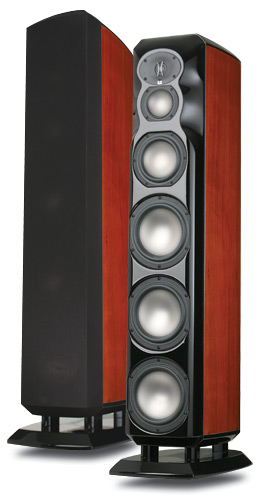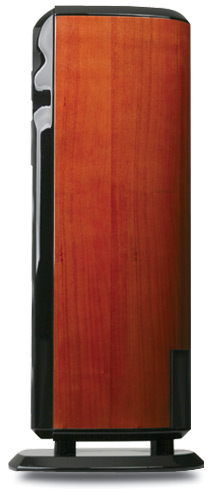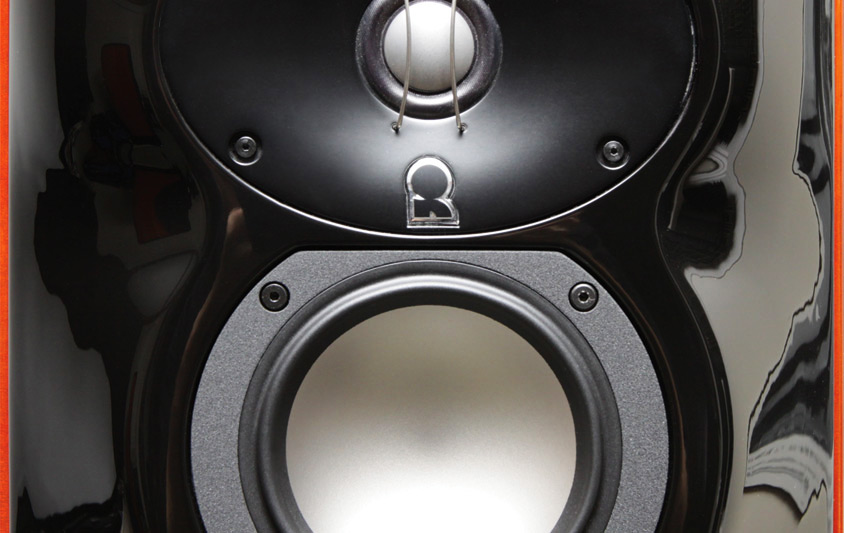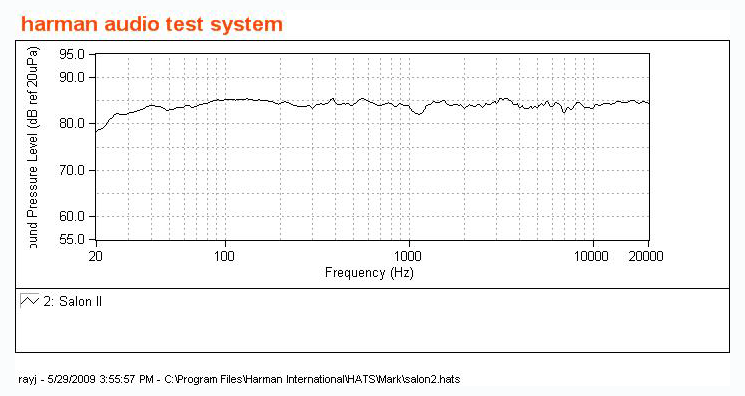 December 2009
Revel Ultima Salon2 Loudspeakers

Category: Edge of the Art


| Associated Equipment Speakers -- Magico V2, PSB Synchrony One, Mirage OM
Design OMD-28
Preamplifiers -- Blue Circle Audio BC3000
Mk.II, Benchmark Media DAC1 HDR, Anthem Statement D2v
Power amplifiers -- Blue Circle Audio BC204,
Stello M200
Integrated amplifiers -- Classé Audio
CAP-2100, Zandèn Audio Model 600
Digital sources -- Simaudio Moon Evolution
SuperNova CD player; Benchmark Media DAC1 HDR, Stello DA220 Mk.II, Blue Circle Audio BC501 D/A
converters
Speaker cables -- DH Labs Silver Sonic Q-10
Signature
Analog interconnects -- Nirvana Audio S-L,
Nordost Quattro Fil
Digital interconnects -- Nirvana Audio
Transmission Digital, i2Digital X-60 |
|
|
|
 A motorcycle enthusiast once told me
that "People who think they’re into motorcycles but are only interested in one
brand of bikes aren’t really into motorcycles at all; instead, they’re into a
certain motorcycle brand." He mentioned, as an example, all the weekend
warriors who ride Harley-Davidsons and think it’s the only bike to have. I asked our
own Jason Thorpe, a motorcycle enthusiast, about this, and he told me that similar things
happen with bikes made by Ducati. If not contained, such brand worship can be like a
religion to some -- and, if it goes far enough, almost a cult. A motorcycle enthusiast once told me
that "People who think they’re into motorcycles but are only interested in one
brand of bikes aren’t really into motorcycles at all; instead, they’re into a
certain motorcycle brand." He mentioned, as an example, all the weekend
warriors who ride Harley-Davidsons and think it’s the only bike to have. I asked our
own Jason Thorpe, a motorcycle enthusiast, about this, and he told me that similar things
happen with bikes made by Ducati. If not contained, such brand worship can be like a
religion to some -- and, if it goes far enough, almost a cult.
I can’t help thinking of a similar phenomenon in
high-end audio, particularly as it applies to loudspeakers. Some reviewers focus almost
exclusively on the offerings of just one brand, or on a certain type of technology or
speaker design, fixating on it to the exclusion of everything else. Is an intervention
necessary? Sometimes -- because it’s shortsighted and, in fact, wrong.
As a professional reviewer, I love to -- indeed, I feel
that I must -- review all kinds of speakers made by many different companies and
across many different price ranges. Each seems to offer something a little bit different,
and I have yet to find a perfect design -- even if some designers think they’ve
created it, it just doesn’t exist. (The reasons no "perfect" loudspeaker
exists, and probably never can, would require an article longer than this review.) When
you realize this and open yourself up to what’s out there, you find a nearly endless
array of speaker products to discover -- and, if you’re me, review.
Which is why I’m pleased to review Revel’s Ultima
Salon2 ($21,998 USD per pair), the successor to the Ultima Salon, which was introduced in
1998 and sold until about two years ago. Revel is owned by Harman International, the large
company that also owns the Infinity, JBL, Lexicon, and Mark Levinson brands. The Salon2,
Revel’s highest-priced speaker, is claimed to incorporate all of the
speaker-engineering knowhow Revel has gathered to date; in short, it’s their shot at
the state of the art. Given that, there was only one thing this loudspeaker enthusiast and
reviewer could say when Harman offered me a pair for review: Bring it on!
Description
The Ultima Salon2 looks deceptively small -- its sculpted
baffle, angled top piece, and rounded sides eliminate the blockiness so common in larger
speakers. It measures 54"H x 14"W x 23"D and weighs about 160 pounds. The
Salon2 is baffle-heavy -- that front panel is 2.5" thick, and the drivers mounted to
it are themselves weighty -- which can make it tricky to carry. We carried each speaker up
two flights of stairs, pointing the drivers ceilingwards to keep from poking a finger
through them, but the Salon2s constantly wanted to flip themselves over. It’s
definitely a job for two or more men to carry them as we did. Have a strong grip and be
ready to break a sweat.
The baffle, base, and top piece are all made from solid MDF
finished in black lacquer. The rear and side panels comprise a single sheet of nine-ply
MDF that gently curves around the sides and is more tightly curved around the back. This
eliminates joins at the rear, which makes for a stronger cabinet than a traditional box
with joined corners. This single sheet, which comprises the bulk of the speaker’s
surface area, comes finished in black lacquer or mahogany real-wood veneer, both
high-gloss. Extensive internal bracing makes the cabinet more rigid, and large spikes
(supplied) screw into the bottom of the base to make the speaker more stable on carpeted
floors.
Examine the baffle closely and you’ll notice that it
has no sharp edges. I spoke with Kevin Voecks (Director of Product Development for Harman
High-Performance AV) at length earlier in 2009, and he told me that he’d used
computer modeling to eliminate such edges and, thus, diffraction effects. Kevin provided
me with a white paper that compared frequency-response measurements taken of the same
drivers mounted in a flat-baffled, sharp-edged cabinet, and in the more sculpted cabinet
of the Salon2. The differences are profound.
The speaker’s removable grille is a brilliant design
-- basically, a frame of thick wire covered with acoustically transparent cloth that
provides minimal obstruction to the soundwaves emitted by the drivers. Magnets in the
baffle hold the grille firmly in place and allow it to be easily removed and replaced.
Usually when I review a pair of speakers, I remove the grilles, as many of them severely
degrade the sound. But I did a lot of my listening to the Salon2s with their grilles in
place; they seemed to have negligible effect.
The Salon2 is a four-way design that uses proprietary Revel
drivers, including a 1" dome tweeter of pure beryllium with a specially shaped
waveguide to improve dispersion and increase efficiency. Beryllium is used because its
first breakup mode is at about 45kHz -- far, far above the audioband, and a lot higher
than aluminum’s breakup mode at about 23kHz, which allows artifacts to trickle down
into the audible range.
The other drivers are inverted-dome designs with titanium
diaphragms and oversized voice-coils wound with flat-ribbon wire, which helps improve
power handling: a 4" upper midrange, a 6.25" lower midrange, and three 8"
woofers. Fourth-order, phase-correct crossover slopes are used throughout to blend the
drivers’ outputs. The woofers are crossed over to the lower midrange at 150Hz, the
lower midrange to the upper midrange at 575Hz, and the upper midrange to the tweeter at
2300Hz. The output from the woofers’ backwave exits through a large, flared,
downfiring port on the speaker’s bottom plate -- which is why there’s 2" or
so of clearance on all sides between the bottom of the speaker and its base.
The Salon2 is a true full-range design, with a claimed
frequency response of 17Hz (-10dB) to 45kHz -- but how high and low this speaker can go
isn’t all that matters. Since its inception, Revel has designed all its speakers to
have quite flat frequency response both on and off axis, as well as very low distortion.
"Controlled directivity" is a big deal for this brand. This design methodology
harks back to Dr. Floyd Toole’s work at Canada’s National Research Council
(NRC), which Kevin Voecks is very familiar with. (In the early 1990s, Toole left the NRC
for Harman International, where he became Vice President of Acoustical Engineering,
overseeing product development for all Harman brands.) Harman specs the Salon2’s
Listening Window Response -- an average of the direct response from the speaker taken from
various points directly in front of the baffle -- as 29Hz-18kHz, +/-0.5dB; obviously, very
flat. They rate the speaker’s In-room Response Relative to Target Response as
26Hz-20kHz, +/-1.0dB. This latter figure takes into account not only the direct response
from the speakers, but also the first reflections from the floor, ceiling, and walls, as
well as the reverberant response resulting from the multiple reflections occurring in the
rest of the room.
 The Salon2’s anechoic sensitivity
is said to be 86.4dB/2.83V/m, and its impedance is rated at a nominal 6 ohms, with a low
of 3.7 ohms at 90Hz. You’ll need a reasonably powerful amp to play them to
appreciable volume levels, but you don’t have to go overboard. I used amps rated from
100 to 175Wpc with the Salon2s, and they worked just fine. No doubt you could use
something bigger -- ideally, something rated at 250-300Wpc, if only for that ease and
effortlessness that a really big amp can provide. Unfortunately, I had no such beast on
hand. The Salon2’s anechoic sensitivity
is said to be 86.4dB/2.83V/m, and its impedance is rated at a nominal 6 ohms, with a low
of 3.7 ohms at 90Hz. You’ll need a reasonably powerful amp to play them to
appreciable volume levels, but you don’t have to go overboard. I used amps rated from
100 to 175Wpc with the Salon2s, and they worked just fine. No doubt you could use
something bigger -- ideally, something rated at 250-300Wpc, if only for that ease and
effortlessness that a really big amp can provide. Unfortunately, I had no such beast on
hand.
Two sets of binding posts (for biamping or biwiring) are
mounted on a solid-aluminum panel inset on the rear of the speaker, behind a hinged
plastic door. Jumpers are provided if you want to single-wire the Salon2s (as I did). Also
on the aluminum plate are switches for adjusting the bass output (Normal, Contour,
Boundary) and tweeter level (+/-1dB in 0.5dB increments). I used the Normal bass setting
and left the tweeter flat.
Revel’s Ultima Salon2 carries a hearty price tag and
justifies it, at least in terms of how it’s made and the technology it contains. In
that sense, it’s the most impressive loudspeaker to ever enter my listening room. Of
course, what’s most important is the way it sounds . . .
Sound
The Ultima Salon2 is a large speaker with six drivers that
can move plenty of air -- it needs room to breathe. My room is very large (36’L x
18’W), though I use only the front half for my system (the rest is office space). I
positioned the Salon2s about 9’ apart and 5’ from the front wall. Obviously, the
tempting thing to do with such speakers in a room this size is to put on a large-scale
piece of music and see what they can do -- which is what I did.
I played track 7 of Crystal Cable’s Arabesque
sampler (CD, CC 200901): Mussorgsky’s Pictures at an Exhibition, performed by
Eiji Oue and the Minnesota Orchestra (licensed from Reference Recordings). This
large-scale orchestral work has impressive dynamic swings -- small and intimate one
moment, it then turns on a dime to sound large, loud, and overpowering. It ends with a
whopper of a climax that will test the power supply of your amp and the robustness of your
speakers.
Driven by my Blue Circle Audio BC204, a 150Wpc power amp,
the Salon2s’ output was breathtaking for the way they energized the entire room, and
awe-inspiring for the level of impact and bass slam they could attain. With enough power
behind them, these speakers approached lifelike sound-pressure levels without sounding
strained. They also played as deeply in the bass as their specifications boast, delivering
frequencies so low that I no longer heard but felt them. I’ve had some pretty
big speakers in my room, including JansZen’s fully active Model One and Mirage’s
OMD-28, but the Salon2 presented the best bass I’ve heard here -- deep and
authoritative, with tremendous impact when the music commanded it. The Salon2 is, without
question, a full-range design capable of very high output levels.
The Salon2’s "big sound" was impressive, but
it was when it turned "small" that this speaker really captivated me. I’m a
huge fan of pint-size, two-way, bookshelf models because of how well they can portray
small-scale, intimate music -- there’s a purity in the sound of many small two-ways,
particularly in the midrange, that many larger speakers can’t match. Perhaps it has
to do with the simplicity of the designs. Don’t know. Regardless, the Salon2 may
stand as high as my shoulder and weigh a little more than I do (right now, I’m
dieting), but it did the delicate stuff better than any two-way I know, regardless of
price. It’s a really big speaker that does small really well.
I then played composer-pianist Ola Gjeilo’s Stone
Rose (SACD/CD, 2L 2L48SACD), a wonderful disc that gets my highest marks for sound
quality and performance. Track 3, "Michelle," is a quickly paced piece in which,
at one point, Gjeilo rides up and down the keys at the top end of the keyboard. I marveled
at how precisely and incisively the Salon2s reproduced this passage, and was astounded at
how exactly they could place the image of the piano on the soundstage, to create a clearly
defined, hyperrealistic soundstage. The microdynamics, speed, and transparency, even for
the subtlest sounds, were better than any other speaker I’ve heard. The Salon2 may
have the frequency response of a large floorstander, but it has the specificity,
precision, resolution, purity, and coherence of a small two-way. Amazing.
In fact, I found the Ultima Salon2’s precision and
coherence so uncanny for its large size that, as Gjeilo’s "Michelle"
continued, I removed the grille from one speaker, then put my ear next to each driver to
listen to its contribution to the overall sound. Most of the music seemed to be produced
by the upper-midrange driver, but every driver was contributing something,
depending on where Gjeilo’s fingers were on the keyboard. I replaced the grille and
stood back -- not very far, maybe 3’ -- and was in awe of how coherent and seamless
this large array of drivers sounded from even so short a distance. What’s more, each
keystroke had such solidity, precision, and focus that it sounded as if produced by a real
piano, not a bunch of drivers combining their outputs to reproduce a piano’s
sound. It’s seldom that a pair of speakers reaches this ideal of sounding so real,
but these did. When I sat in my listening chair, it didn’t sound at all like two sets
of six drivers each, in which even the drivers within an individual speaker could be
almost 4’ apart. Instead, those 12 drivers sounded like one -- the hallmark of great
crossover design and great driver integration. The Salon2’s coherence across the
audioband was first-rate.
The tweeter’s performance, too, was at the top of the
heap -- something that surprised me, given my past experience of Revel speakers. I’ve
reviewed two of their small models -- the Performa M22 and M12, each a fraction of the
Salon2’s price and size -- and although their performance was extremely good overall,
their tweeters at times seemed a touch dry, even clinical. And when I’d heard the
original Ultima Salon at trade shows, I’d noticed the same thing: clean but not
sweet.
With the Ultima Salon2, that problem was gone. What’s
more, the highs were so refined that they left me nothing -- absolutely nothing -- to
complain about. The Salon2’s top end was supremely extended, thoroughly effortless,
unbelievably clean, and, finally, extraordinarily sweet, with no hint of dryness or
clinical coldness. All told, the Salon2 had the clearest, sweetest high-frequency sound
I’ve ever heard from a speaker in my room -- just as its bass was. Was this because
the tweeter is made of beryllium? Perhaps, but the design brief supplied goes into great
detail about other aspects of Revel’s tweeter, including its motor structure and
waveguide. The spectacular result is, most likely, the sum of these parts.

The Salon2's tweeter and upper-midrange driver.
I can handle a lack of super-low bass, which is why I can
enjoy minimonitors -- they’re all bass-shy. I can also live with a top end
that’s a touch dry, which is why I could still highly praise those other Revel
models. But every speaker, big or small, has to get the midrange exactly right --
that’s where so much musical content resides, including the human voice. If voices
sound exactly right, you can forgive some little mistakes. But if voices sound wrong, you
may as well throw everything the speaker might be doing right straight out the window.
There’s no wiggle room here.
The earmarks of the Salon2’s middle range were
ruler-flat neutrality (instruments and voices that occupy this region sounded neither
forward nor recessed, but smack-dab in the middle, where they should be), as well as
speed, transparency, and precision akin to those of an electrostatic design. The Salon2
was lightning-fast from top to bottom, but its speed was particularly noticeable in the
midrange. It rendered voices with quickness and immediacy, and with a see-through-ness
that made many other speakers I’ve heard sound veiled. It was also completely devoid
of congestion, woolliness, and other unbearable resonances, even when driven hard. To trip
up the Salon2 and make it sound chesty, even coarse, I played some recordings with heavy,
resonant male voices: Johnny Cash albums produced by Rick Rubin, and a lot of Bruce
Cockburn. Not once did it ever sound anything less than crystalline. Then I tried
recordings of the piano, whose lower registers often reveal resonances. No such luck. No
matter what kind of music I threw at it, the Salon2 sounded nimble, lithe, and clean.
Comparison
When I reviewed Magico’s V2 speaker in July, I
applauded the deep bass it could produce from a cabinet of such modest size, the
speaker’s gutsiness when given enough power (100Wpc at minimum; 200Wpc or more is
preferable), and, mostly, the velvety, seductive nature of its midrange, which is quite
unlike anything else I’ve heard. I wouldn’t say that the V2 is the pinnacle of
neutrality; rather, I’d say that it’s relatively neutral, but expertly
voiced to sound a certain way -- Magico’s way, which happens to be very good, and is
why I called it "the best passive loudspeaker I’ve ever reviewed." I
consider it and the Ultima Salon2 direct competitors, even if the Salon2 costs $4000/pair
more. After all, if someone’s got 18 large, they’ve likely got that four large
more. (Revel also offers the Ultima Studio2 at $15,998/pair, which is closer in price to
the V2, but I haven’t reviewed or heard it.)
The higher price of the Salon2 gets you a larger, heavier,
more complex loudspeaker. The V2 is about 3.5’ tall and weighs 120 pounds, while the
Salon2 is 4.5’ tall and weighs 160 pounds. The V2 is a 2.5-way sealed box (its two
woofers handle the bass, but the range of only one of them extends high enough in
frequency to cross over to the tweeter), while the Salon2 is a four-way with three woofers
and a downfiring port. The smaller V2 will fit more discreetly into a room of moderate
size; the Salon2 will play small-scale music shockingly well, but its size and remarkable
output capabilities make it better suited to a larger room.
The two speakers sound quite different. Not surprisingly,
the larger, ported, triple-woofered Salon2 went deeper in the bass. The V2’s low
frequencies are claimed to extend down to around 30Hz, the Salon2’s to about 20Hz --
that extra reach gives you a touch more "heft" when the music has it. But
that’s not all. Starting at 100Hz, and all the way down from there, the Salon2 had
more impact and thrust -- a punch and visceral quality that the V2 lacks. If you want
full-range bass and have the room for it (not everyone does, and too much bass in
too small a room can be a bad thing), the Salon2 is the ticket.
I like how sweet the V2 sounds up top, but I liked the
Salon2 better -- it sounded just a touch cleaner and conveyed more "air."
That’s not to say I have any objection to the V2’s tweeter -- it’s as good
as or better than most out there -- but that I preferred the Salon2’s, mostly for the
way its output extended so effortlessly beyond the audioband. As I said earlier, the
Ultima Salon2 had the sweetest, clearest high-frequency sound I’ve heard in my room.
It was in the midrange that things got tricky, and where
personal preferences will dictate which of these speakers is "the best." The
Salon2 had a speed and transparency akin to an electrostatic design -- fast, incisive,
precise. However, in comparison to the V2’s midband, which has more than a hint of
richness, the Salon2 sounded leaner. The V2’s comparative richness helps give it that
gutsy sound that I like so much. Male voices have a little more presence with no loss of
detail, while female voices, such as Mariza’s on her Transparente (CD, Times
Square TSQ-CD-9047), have a touch of lushness that they lacked through the Salon2. All
told, the V2 sounds more robust through the midrange.
This difference in the mids could sway someone away from
the Ultima Salon2 to the Magico V2, particularly if they have a smaller room that
can’t accommodate a pair of Salon2s. The V2’s intoxicating, unique sound -- as I
said, it’s expertly voiced -- makes it a great, moderate-size loudspeaker. But while
I like what the V2 does, particularly in the midrange, I found the Salon2 the better
speaker overall in my very large room, which easily supports this speaker’s deep,
deep bass and high output capability, and because I treasure the Salon2’s incisive,
lightning-fast sound.
Conclusion
No loudspeaker is perfect, but Revel’s Ultima Salon2
is the closest I’ve found. Its bass and high-frequency performance are beyond
reproach, and its midrange deserves high praise for its neutrality, transparency, and
speed. Some might wish for a little more of the midrange richness of, say, the Magico V2,
but this would be more about desiring a certain type of sound rather than indicating any
deficiency in the Salon2. From top to bottom, The Salon2 is an ultraprecise, remarkably
refined, full-range transducer that delivers nothing short of state-of-the-art sound while
making fewer compromises than any other speaker I’ve heard.
I foresee two main problems for the Salon2. First, it will
be too big for some rooms -- though its footprint is modest, the speaker’s height
makes it rather imposing, and its extreme-low-output bass could overload small rooms.
Second is the price -- $22,000 can buy you a pretty good car, so it’s not exactly
pocket change, particularly in these trying economic times. On the other hand, there are
speakers costing much more that don’t offer the Salon2’s performance,
technology, or build quality. It may not be cheap, but it’s worth the asking price.
If you have the space, the money, and the desire to own a
"statement" loudspeaker that can take its place among the greats, Revel’s
Ultima Salon2 is the one to look at. I’m sure someday I’ll review an even better
speaker -- progress is defined by the continuing search for perfection -- but for now,
at least, the Ultima Salon2 is the best passive loudspeaker I’ve ever reviewed.
. . . Doug Schneider
das@soundstage.com
Revel Ultima Salon2 Loudspeakers
Price: $21,998 USD per pair.
Warranty: Five years parts and labor.Revel
1718 W. Mishawaka Rd.
Elkhart, IN 46517
Phone: (516) 594-0300
Website: www.revelspeakers.com |
Revel responds:
Thank you for your kind and thorough review of the Salon2s.
I am very proud of our engineering team, and it is very rewarding to get a review that
recognizes salient characteristics that are often overlooked. I strongly applaud your use
of the NRC chamber to provide meaningful measurements for your readers. I believe that a
closer look at the challenges of accurately characterizing low-frequency performance would
be of interest to your readers. Anechoic chambers are only anechoic down to a certain
frequency, depending on the length of the wedges. The NRC chamber is anechoic down to
about 100Hz. Below that it is possible to electrically equalize the signals from the
microphones to compensate for errors -- at least at one point in space. Large speakers
such as the Salon2 still pose a problem, as the three woofers, mid-woofer and port are
widely separated, and, of course, cannot all be at the equalized point simultaneously. A
good approximation can be made by measuring the total sound power of the speaker, as long
as the chamber is properly electrically calibrated below its anechoic capability.
Ironically, this situation results in larger loudspeakers
with extended low-frequency response to appear to be more bandwidth-limited than a simple
two-way box with reasonable extension. The most accurate characterization at very low
frequencies is achieved by making "volume displacement" measurements, which are
then spliced to the higher-frequency-range data. This provides a very high signal-to-noise
ratio, while eliminating the need for error-prone splicing of port and transducer
contribution (which can never be summed from multiple "close-microphone"
measurements with any degree of accuracy). I have attached a curve of the Salon2 with the
low-frequency sound power spliced to the listening-window response for comparison to the anechoic on-axis curves. Needless to say, it should be noted that the
room modes and boundary gain dominate below around 300-400Hz.

Best regards,
Kevin Voecks
Harman High-Performance AV
|

